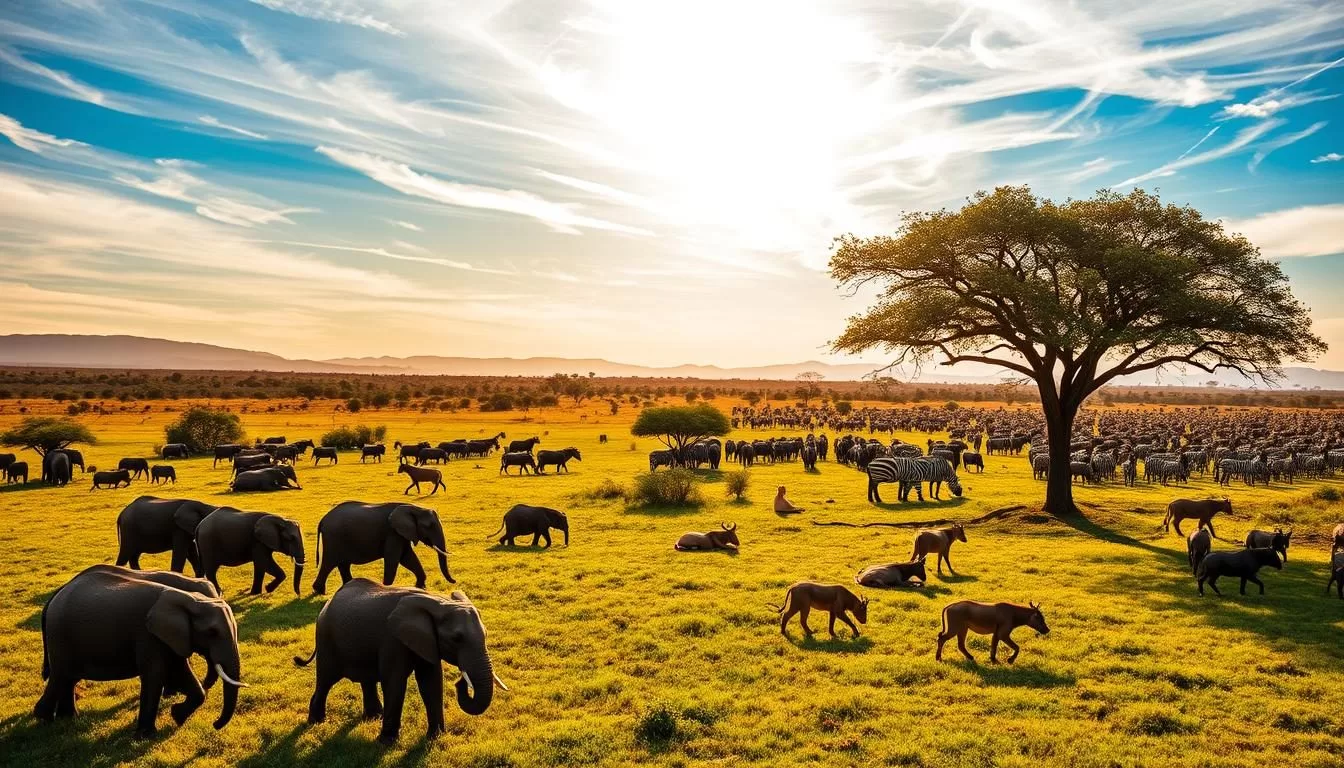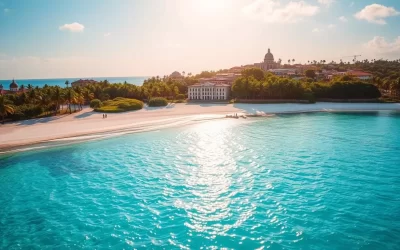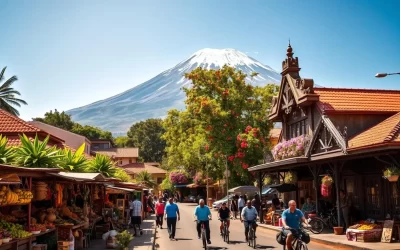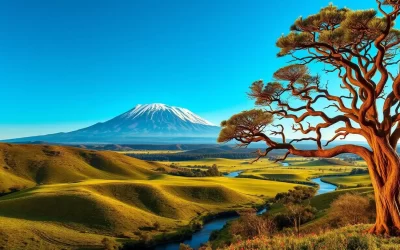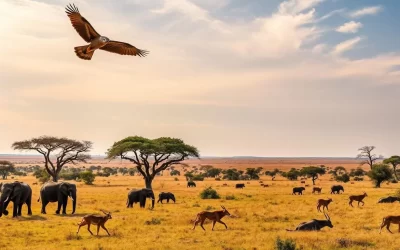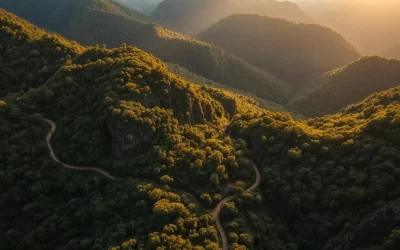Welcome to Tarangire National Park, a hidden gem in the heart of Tanzania. This captivating wilderness area spans approximately 2,850 square kilometers, offering diverse landscapes and abundant wildlife.
As you explore this national park, you’ll discover vast savannahs, ancient baobab trees, and a rich cultural heritage. The park is renowned for its massive elephant herds and tree-climbing lions, making it an ideal destination for a safari experience.
You can tailor your visit to span from a single day to several days, depending on how deeply you want to explore this magnificent wilderness. Whether you’re planning your first African safari or you’re a seasoned traveler, Tarangire offers experiences that will create lasting memories.
Discovering Tarangire National Park: Tanzania’s Hidden Gem
As you step into Tarangire National Park, you’re immediately immersed in a world of stunning landscapes and diverse wildlife. This Tanzanian gem is renowned for its high density of elephants and iconic baobab trees.
Location and Size of the Park
Tarangire National Park is located in northern Tanzania, covering an area of approximately 2,850 square kilometers. The park’s diverse habitats, including grasslands, swamps, and woodlands, support a wide range of animals and trees, making it a unique destination for nature enthusiasts.
What Makes Tarangire Special
Several factors make Tarangire National Park stand out. The park is home to over 300 elephants, offering a chance to witness these majestic creatures up close. The landscape is dotted with ancient baobab trees, some estimated to be over 600 years old, creating an otherworldly atmosphere.
| Feature | Description |
|---|---|
| Elephant Population | Over 300 elephants, one of the highest densities in Africa |
| Baobab Trees | Iconic, ancient trees, some over 600 years old |
| Wildlife Diversity | Supports a wide range of animals, including wildebeest, zebras, giraffes, and hippos |
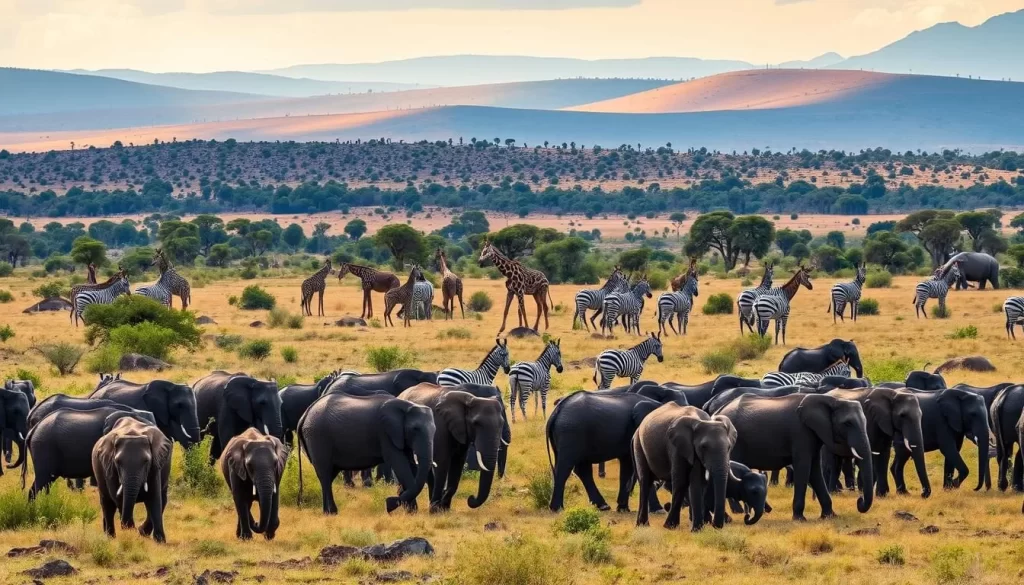
Best Time to Visit Tarangire National Park
Tarangire National Park is a year-round destination, but the experience varies significantly depending on the season you choose to visit. Understanding the park’s seasonal dynamics is crucial for planning an unforgettable safari.
Dry Season: Peak Wildlife Viewing
The dry season, from June to October, is considered the peak time for wildlife viewing in Tarangire. During this period, animals congregate around the remaining water sources, making them easier to spot. The dry landscape also improves visibility, enhancing your wildlife viewing experience. You can expect to see a variety of animals, including zebras, as they gather around the Tarangire River and other waterholes.
Wet Season: Lush Landscapes and Birdwatching
In contrast, the wet season, spanning from November to May, transforms Tarangire into a lush, green paradise. This period is ideal for bird enthusiasts, as migratory species arrive, and resident birds display their breeding plumage. Although many large mammal herds disperse during the rainy season, you’ll still encounter resident wildlife and enjoy the benefits of fewer tourists and lower accommodation rates. Be prepared for occasional rain showers and cooler temperatures, ranging between 55-63°F (13-17°C). The wet season also showcases Tarangire’s remarkable ability to transform from a parched savannah to a verdant wilderness, offering photographers stunning landscape opportunities.
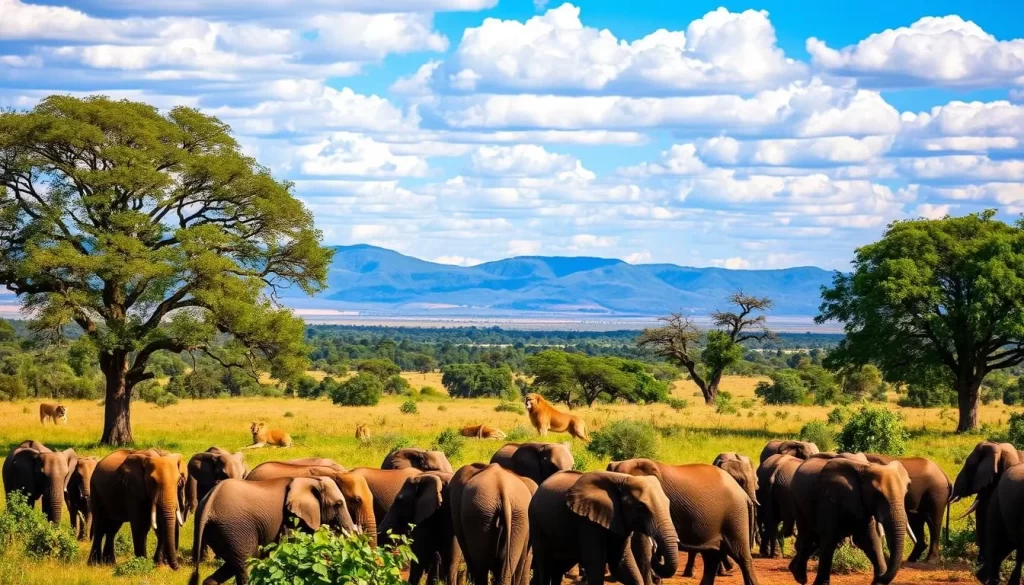
Visiting during the wet season allows you to appreciate the park’s complete ecological cycle and observe how nature adapts to the changing conditions throughout the year. With proper insect protection, you can enjoy the beauty of Tarangire in a different season, making your visit a unique experience.
How to Get to Tarangire National Park
Getting to Tarangire National Park is relatively simple, whether you’re starting from Arusha or Kilimanjaro International Airport. The park’s accessibility is one of its many advantages for visitors planning a Tanzania safari.
From Arusha and Kilimanjaro International Airport
Most visitors to Tarangire National Park begin their journey from Arusha, a city well-connected to Kilimanjaro International Airport. You can easily arrange for transportation from either location to the park. Many tour operators offer pick-up services from your accommodation in Arusha or directly from the airport, making the logistics of your trip seamless.
Transportation Options
You have several transportation options for your Tanzania safari to Tarangire. Most visitors choose to book through a tour operator that provides a 4×4 safari vehicle with a driver-guide. This option is highly recommended as it includes the expertise of a guide who knows the park and its wildlife.
| Transportation Method | Description | Cost |
|---|---|---|
| Tour Operator with 4×4 Vehicle | Includes driver-guide, suitable for safari | $150-$700 per person per day |
| Self-driving | Possible but not recommended for inexperienced drivers | Variable, depending on vehicle rental |
| Group Safari | Budget-friendly, shared with other travelers | $50 (entrance fee) + variable safari costs |
For a safari experience in Tarangire park, the duration of your stay can vary. Many visitors spend just one day in Tarangire as part of a longer northern Tanzania safari circuit, though staying for 2-3 days allows for a more thorough exploration of the park.
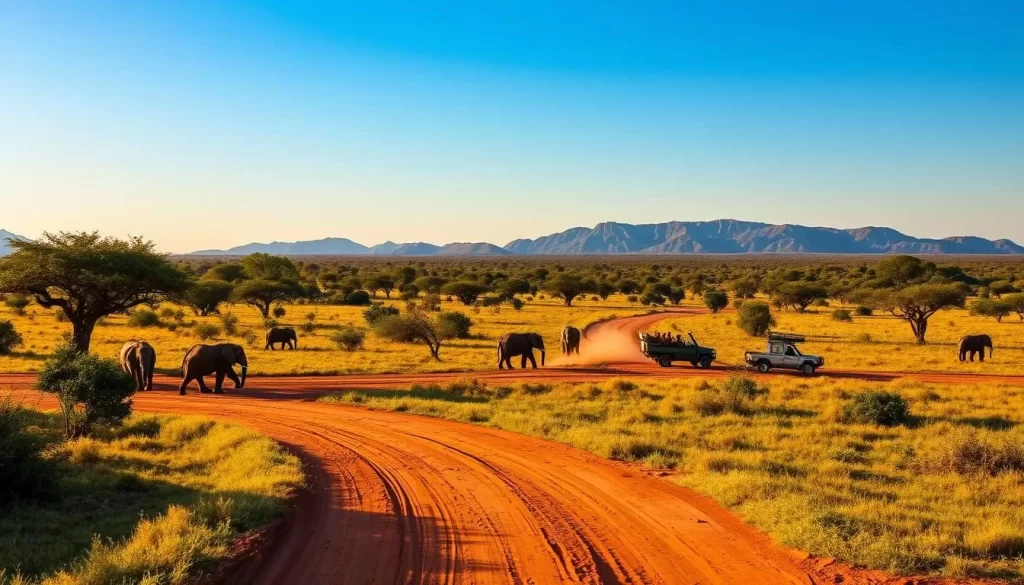
Wildlife Encounters in Tarangire National Park
The wildlife encounters in Tarangire National Park are truly exceptional, with opportunities to spot a wide variety of animals in their natural environment. As one of the most seasonal parks in northern Tanzania, Tarangire experiences significant migratory movements within the greater Tarangire ecosystem.
The Elephant Haven: Largest Elephant Population in Tanzania
Tarangire National Park is home to the largest elephant population in Tanzania. During the dry season, which spans from June to October, the park becomes a haven for these majestic creatures. The Tarangire River, with its reliable water source, attracts large herds of elephants, making it an ideal location for observing these gentle giants up close.
Predators and Rare Animal Sightings
In addition to its impressive elephant population, Tarangire is also known for its diverse array of predators and rare animal sightings. Visitors can expect to see lions, leopards, and other predators that roam the park. The concentration of prey animals during the dry season naturally attracts these predators, providing a unique opportunity to witness the full circle of life in the African wilderness.
The Great Wildlife Migration
Tarangire National Park hosts its own unique wildlife migration during the dry season. Thousands of animals, including wildebeest, zebras, and buffalo, converge on the park in search of water. This migration, while not as famous as the Serengeti’s Great Migration, is equally impressive and offers a distinct wildlife viewing experience.
| Animal | Season | Notable Facts |
|---|---|---|
| Elephants | Dry Season (June-October) | Largest population in Tanzania |
| Wildebeest, Zebras, Buffalo | Dry Season (June-October) | Massive herds migrate to Tarangire River |
| Lions, Leopards | Year-round | Predators attracted to prey concentrations |
Tarangire National Park, Tanzania: Best Things to Do – Top Picks
From game drives to balloon safaris, Tarangire National Park is a haven for adventure seekers. With its diverse landscapes and rich wildlife, the park offers a unique experience for every visitor.
Game Drives: Witnessing African Wildlife
Game drives are a quintessential part of any safari experience in Tarangire. You’ll have the opportunity to witness a wide range of African wildlife in their natural habitat, from majestic elephants to predators like lions and leopards. The park’s vast plains provide an ideal setting for spotting wildlife.
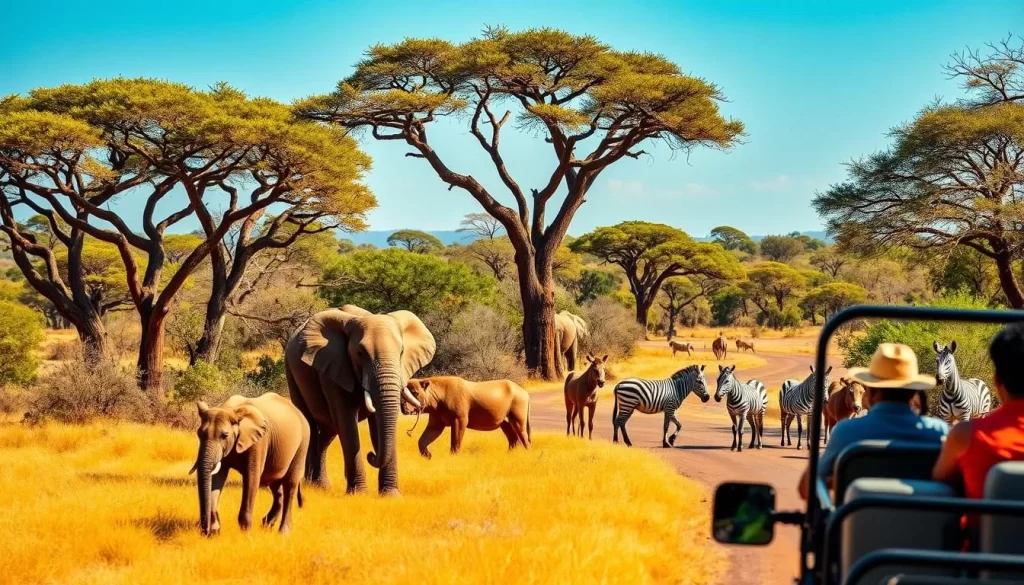
Walking Safaris: Exploring on Foot
For a more immersive experience, consider a walking safari. Led by experienced guides, you’ll explore the park’s diverse nature on foot, gaining a deeper appreciation for the flora and fauna.
Night Safaris: Nocturnal Adventures
Night safaris offer a unique perspective on the park’s wildlife, allowing you to witness nocturnal animals in their natural habitat. This is a thrilling way to experience Tarangire after dark.
Balloon Safaris: Soaring Above the Savannah
For a truly unforgettable experience, take to the skies with a balloon safari. You’ll soar above the plains of Tarangire, witnessing breathtaking views of the savannah and its inhabitants. It’s a serene and majestic way to appreciate the park’s vast landscapes.
Balloon safaris typically begin before dawn, with a pre-flight briefing followed by the inflation of the balloon. As you float silently above the landscape, you’ll gain a unique perspective on the park’s geography and wildlife movements. The experience culminates with a champagne breakfast in the bush after landing.
Birdwatching Paradise: 550+ Species to Discover
With its diverse habitats, Tarangire National Park attracts a wide variety of birdlife, making it a paradise for birdwatchers. The park is home to over 550 species, ranging from waterbirds and raptors to colorful songbirds.
Endemic Bird Species to Look For
Tarangire National Park is a haven for endemic bird species. Some of the special birds you can spot include the Vulturine Guinea fowl, Black-headed heron, and African Marsh Harrier. The swamp areas are particularly rich in birdlife, with species like the Water thick-knee, Von der Decken’s hornbill, and Slate-colored boubou. You might also catch a glimpse of the Donaldson-Smith’s nightjar or the majestic Great white pelican.
Best Birdwatching Spots in the Park
The Silale Swamps in the southern part of the park are a hotspot for bird diversity. The Tarangire River and its surrounding vegetation are another prime area for spotting kingfishers, herons, and various waterfowl. For the best birdwatching experience, visit during early morning or late afternoon when birds are most active.
| Location | Bird Species | Best Time |
|---|---|---|
| Silale Swamps | Vulturine Guinea fowl, African Marsh Harrier | Early morning |
| Tarangire River | Kingfishers, herons, waterfowl | Late afternoon |
| Acacia woodlands | Lilac-breasted rollers, superb starlings, hornbills | Throughout the day |
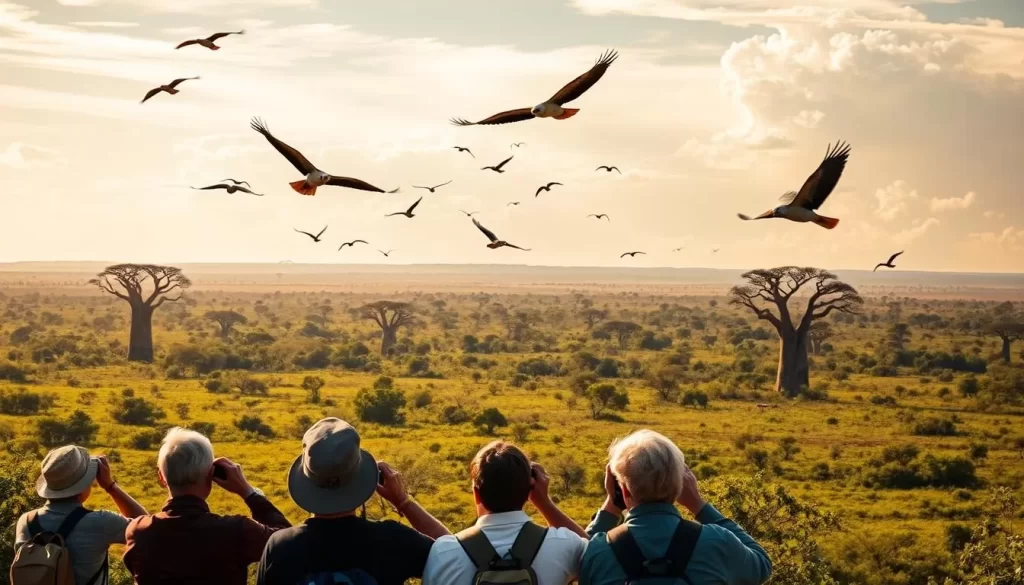
Unique Natural Features of Tarangire
As you explore Tarangire, you’ll discover a diverse range of natural features that make this park a standout destination. The park’s landscape is dotted with iconic landmarks that not only add to its beauty but also support a rich variety of wildlife.
Ancient Baobab Trees: The Giants of Tarangire
Tarangire is famous for its ancient baobab trees, some of which are believed to be over 1,000 years old. These giant trees are a striking feature of the park’s landscape, providing shade and habitat for a variety of animals and birds. The baobabs are not just visually stunning; they also play a crucial role in the ecosystem, supporting the park’s biodiversity.
Tarangire River and Silale Swamps
The Tarangire River is the park’s lifeline, flowing north to south and providing essential water even during the driest months. The river, along with the Silale Swamps, creates a unique ecosystem that supports a wide range of wildlife, including elephants, buffaloes, and various bird species. The swamps, found mainly in the southern and eastern parts of the park, offer a habitat for specialized wildlife such as tree-climbing pythons and lions.
| Feature | Description | Wildlife Supported |
|---|---|---|
| Tarangire River | Lifeline of the park, providing water year-round | Elephants, buffaloes, various birds |
| Silale Swamps | Unique ecosystem with wet conditions year-round | Tree-climbing pythons, lions, African wild dogs |
The contrast between the dry savannah and the lush swamplands showcases the remarkable diversity of habitats within Tarangire’s boundaries. These water features create natural boundaries and corridors that influence animal movements throughout the park, shaping the ecosystem in fascinating ways.
Where to Stay in Tarangire National Park
Tarangire National Park provides a variety of places to stay, ensuring a comfortable safari experience. You can choose from a range of accommodations that cater to different needs and budgets.
Luxury Lodges and Tented Camps
For a luxury experience, Tarangire offers high-end lodges and tented camps. These provide premium amenities and services, making your Tanzania safari even more enjoyable. Many of these luxury options are located within or near the park, offering easy access to parks attractions.
Some luxury lodges offer package deals that include game drives and meals, making it easier to plan your trip.
Budget-Friendly Options
If you’re on a tighter budget, don’t worry – there are several budget-friendly options available. Camps like Baobab Tented Camp and Balloon Camp Tarangire offer comfortable stays starting at just under $300 per night for two people sharing. You can enjoy your safari experience without breaking the bank.
- You don’t need a luxury budget to experience Tarangire.
- Most budget-friendly options are located just outside the park or in the northern section.
- Many affordable options operate year-round, giving you flexibility when planning your trip.
- Consider visiting during the shoulder seasons for significant discounts.
Planning your stay according to the days and year can help you make the most of your visit.
Conclusion: Planning Your Perfect Tarangire Adventure
Imagine immersing yourself in the splendor of Tarangire, where Africa’s wilderness reveals its true beauty. Tarangire National Park offers an unparalleled safari experience, with its vast plains teeming with wildlife, including massive elephant herds.
You now have the insights to plan your trip. The dry season (June to October) is ideal for wildlife viewing, with elephants, wildebeest, zebras, and buffalo congregating around the Tarangire River. Spend at least two days to appreciate the diverse habitats, from baobab-studded plains to the Silale Swamps.
With various safari activities and accommodations ranging from luxury lodges to budget-friendly options, Tarangire National Park promises an unforgettable adventure. Experience the rhythm of life on the African savannah, where every moment is a connection with nature.
